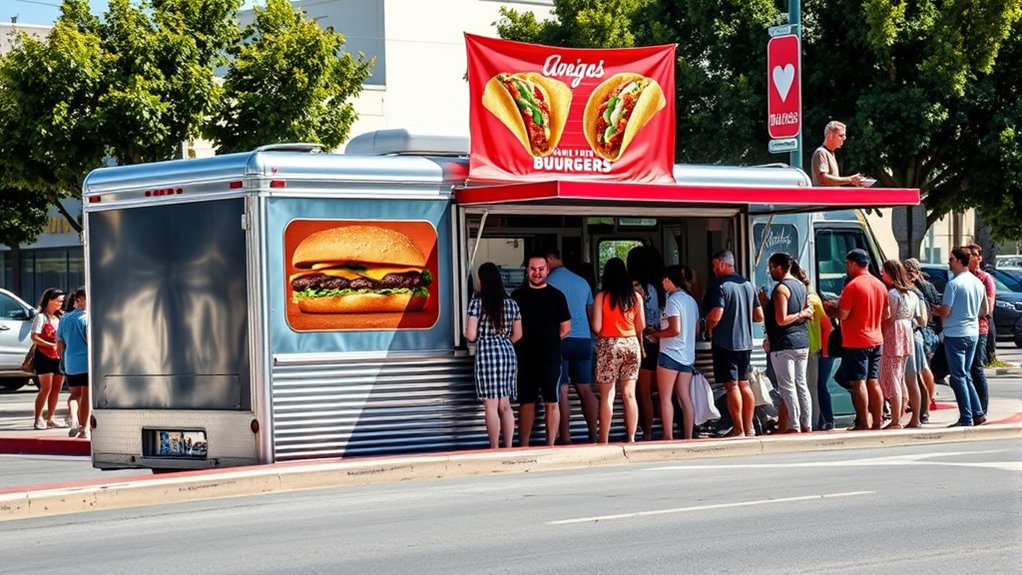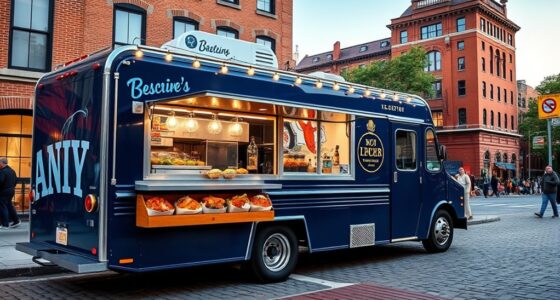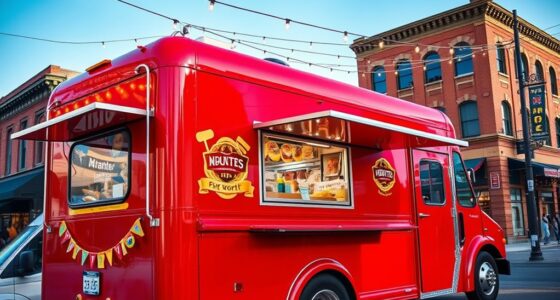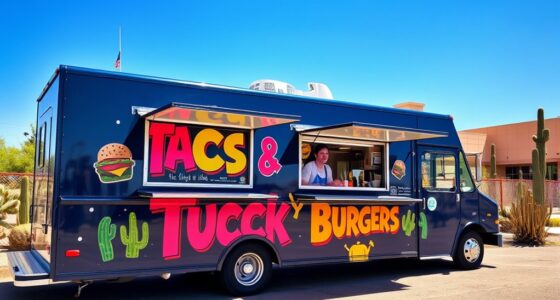To start a food truck in Ontario, CA, you’ll need to create a solid business plan, understand local permits, and comply with health and zoning regulations. Find a suitable base of operations, consider financing options, and choose equipment that fits your menu. Focus on appealing design, effective marketing, and participating in local events to boost visibility. Keep exploring for detailed steps and insider tips to turn your food truck dream into reality.
Key Takeaways
- Research Ontario, CA’s specific food truck permits, zoning laws, and licensing requirements through the city’s official website.
- Develop a detailed business plan including menu, target market, branding, and budget for startup costs.
- Secure a shared commercial kitchen license or establish your own compliant kitchen space.
- Obtain necessary health permits, food safety certifications, and display all permits visibly on your truck.
- Explore financing options and insurance coverage tailored for food trucks to protect your investment and ensure compliance.
Starting With a Business Plan
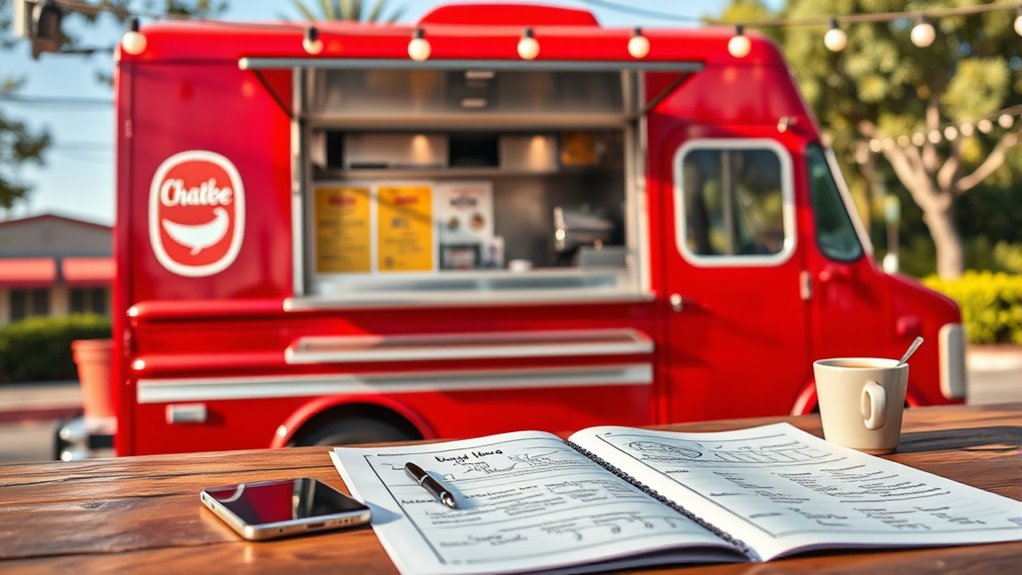
Creating a solid business plan is the vital first step when starting a food truck in Ontario, CA. This plan helps you outline your goals, target market, and menu concept, setting a clear path forward. As you develop your plan, consider your food truck design—how it’ll attract customers and fit your brand. You’ll also need to research vendor permits, which are essential for legal operation and compliance with local regulations. Securing these permits early ensures you avoid delays or fines down the line. Your business plan should include budget estimates, marketing strategies, and a timeline for launch. Additionally, incorporating space and organization strategies can help streamline operations and optimize your truck’s layout, making daily tasks more efficient. By laying this groundwork, you’ll be better prepared to navigate the complexities of starting and sustaining a successful food truck business in Ontario.
Understanding Local Requirements
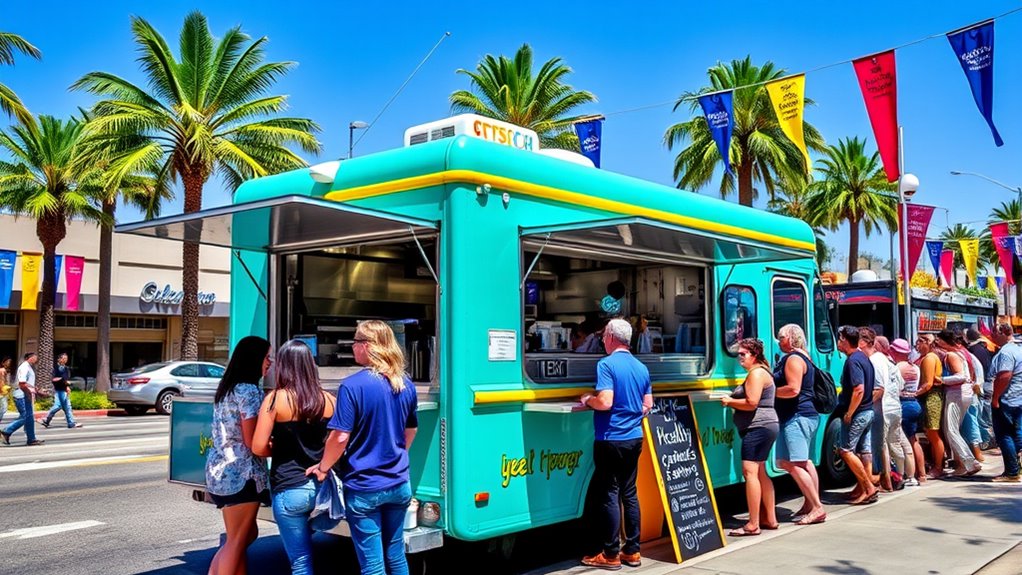
To operate your food truck in Ontario, CA, you need to understand local requirements like the online permit application process and sanitation protocols. You’ll also need to know about record-keeping rules and designated vendor zones. Getting these details correct ensures you stay compliant and avoid fines. Additionally, being aware of health regulations related to food safety and cleanliness is essential for a successful business.
Online Permit Application Process
Are you unsure how to navigate the online permit application process for a food truck in Ontario, CA? First, visit the city’s official website and locate the permit section. You’ll need to fill out the application forms, which include details about your food truck, business plan, and proof of insurance. Make sure your food truck branding is consistent and professional, as it may be reviewed during the process. Prepare digital copies of all required documents before submitting. Once submitted, monitor your email for updates or additional requests. Using social media marketing can help you build a strong online presence, which may support your permit approval. Staying organized and following each step carefully guarantees a smoother application experience.
Sanitation Protocols and Record-Keeping
Understanding local sanitation requirements is essential for keeping your food truck compliant and ensuring customer safety. You must follow specific food safety guidelines, including proper cleaning procedures for all surfaces, utensils, and equipment. Regular sanitation helps prevent contamination and foodborne illnesses. Keep detailed records of your cleaning routines, inspections, and any maintenance performed. These records prove you adhere to local health regulations and are vital during inspections. Make sure to use approved cleaning agents and document their use correctly. Staying up-to-date with Ontario, CA’s sanitation protocols ensures you meet the health department’s standards. Consistent record-keeping not only maintains compliance but also promotes a culture of safety, protecting your customers and your business reputation.
Designated Vendor Zones
Proper sanitation and record-keeping are vital for compliance, but knowing where you can operate is equally important. In Ontario, CA, street food vendors must adhere to designated vendor zones approved by local authorities. These zones help manage traffic flow and guarantee public safety. Before setting up, check with the city’s vendor permit requirements to confirm your location is authorized for street food sales. Some zones have specific hours and restrictions, so understanding these rules helps avoid fines or shutdowns. Many areas require you to display your permits visibly and follow zoning regulations. By operating within designated vendor zones, you ensure your food truck complies with local laws and provides a safe, enjoyable experience for customers. Proper knowledge of these zones is essential for a successful street food business.
Setting Up Your Base of Operations
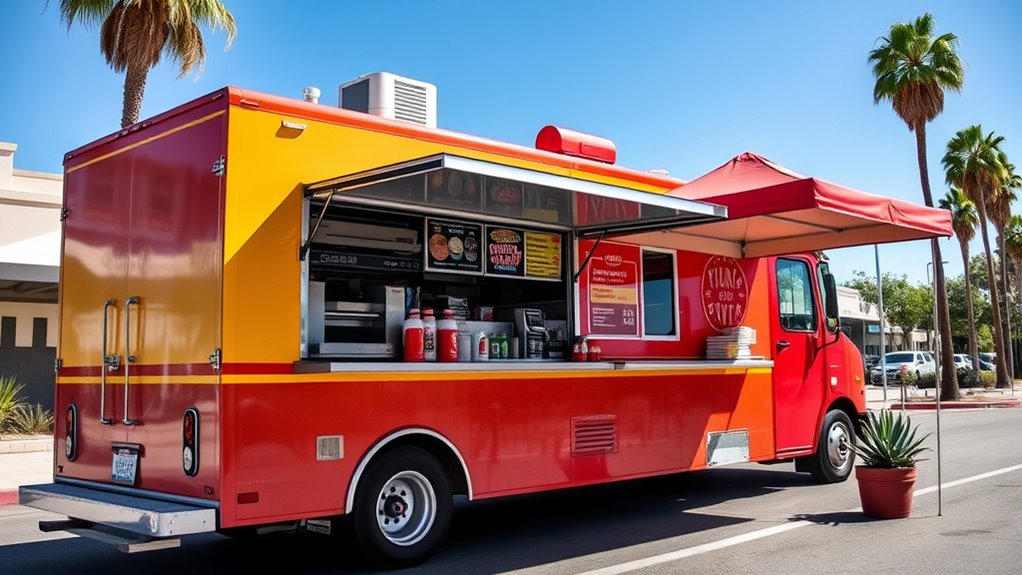
Choosing the right shared kitchen licensing options can save you time and money, so consider what’s available in Ontario. Selecting custom kitchen equipment guarantees your setup meets your specific cooking needs and complies with local standards. By carefully planning your base of operations, you set a solid foundation for your food truck business to thrive. Understanding ethical hacking principles can also help you protect your business from cyber threats as it grows.
Shared Kitchen Licensing Options
Setting up your food truck in Ontario, CA, often means exploring shared kitchen licensing options that can save you time and money. Using shared kitchen licensing allows you to operate in a licensed, inspected space without the costs of building your own commercial kitchen. You can obtain rental kitchen permits, which give you legal access to a fully equipped facility. Picture yourself working in a bustling, well-maintained kitchen with stainless steel counters, commercial ovens, and prep stations ready for your culinary creations.
- Bright, organized spaces with ample storage
- State-of-the-art refrigeration units
- Multiple cooking stations for diverse menus
- Easy access to sanitation and safety equipment
Custom Kitchen Equipment Selection
When selecting your kitchen equipment, focus on building a setup that matches your menu and workflow, ensuring efficiency and quality. Your kitchen layout should facilitate smooth movement and easy access to tools, minimizing delays during service. Choose durable, easy-to-clean appliances that suit your menu needs, like grills, fryers, or prep stations. Prioritize equipment maintenance by selecting brands known for reliability and offering good support. Regular upkeep prevents breakdowns and keeps your food truck running smoothly. Avoid overcrowding your space; efficient placement of equipment improves operational flow. Keep in mind that well-planned equipment selection not only enhances productivity but also reduces long-term costs by limiting repairs and replacements. Properly chosen, your kitchen setup becomes the backbone of your food truck’s success.
Budgeting and Financing Your Food Truck
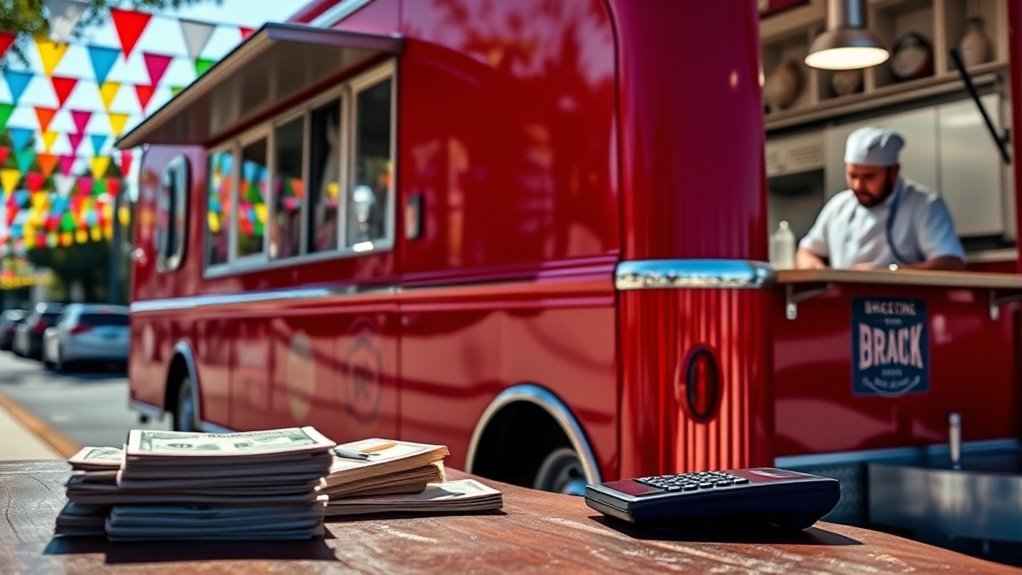
When planning your food truck, you need to budget for initial vehicle modifications and branding to attract customers. Exploring your financing options, like commercial vehicle loans, can help manage costs efficiently. Don’t forget to take into account liability coverage limits to protect your investment and stay compliant with local regulations. Additionally, understanding the vetted safety measures for your vehicle and operations can minimize risks and enhance customer trust.
Initial Vehicle Modifications and Branding
Budgeting for your food truck’s initial modifications and branding is crucial to guarantee you get the most value without overspending. Focus on vehicle customization that enhances functionality and attracts customers, like installing a reliable cooking setup and efficient storage. Your branding strategies should make your truck stand out; think bold colors, eye-catching logos, and clear signage. Visualize your truck with vibrant artwork, personalized menus, and a memorable logo that reflects your cuisine. Prioritize modifications that boost efficiency and appeal, avoiding unnecessary upgrades. Keep costs in check by sourcing affordable materials and DIY options when possible. Remember, a well-branded, customized vehicle not only draws attention but also builds your brand identity from the start. Proper budgeting ensures your investment delivers maximum impact and longevity.
Commercial Vehicle Financing Options
Securing the right financing options is essential to making your food truck project financially sustainable. You’ll want to explore leasing options, which can reduce upfront costs and provide flexibility as your business grows. Leasing allows you to acquire a reliable vehicle without tying up large amounts of capital, freeing funds for other startup expenses. Additionally, consider your auto insurance needs; proper coverage protects your investment and ensures compliance with local regulations. Many lenders offer specialized financing for food trucks, often tailored to your business’s cash flow. Shop around for the best interest rates and terms, and don’t forget to compare leasing options and auto insurance packages. With the right financing plan, you’ll be well on your way to launching a successful food truck in Ontario, CA.
Liability Limits for Coverage
Choosing appropriate liability limits is essential for managing your food truck’s insurance expenses while ensuring sufficient protection. Your liability coverage should balance affordability with enough coverage to handle accidents or damages. Setting insurance limits too low could leave you vulnerable, while excessive limits may raise costs unnecessarily. Consider these factors:
- Potential damage to other vehicles or property during a busy lunch rush
- Medical expenses for injuries caused by your food truck
- Legal costs if you’re sued after an incident
- The value of your food truck and equipment in case of a total loss
Designing Your Menu and Pricing Strategy
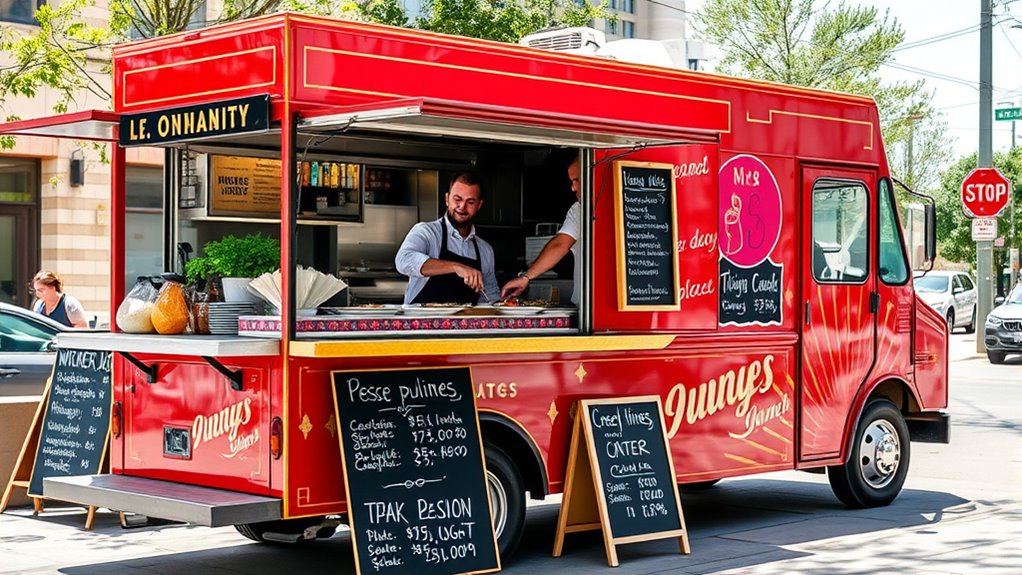
When designing your menu, focus on selecting locally sourced ingredients to appeal to customers and support community farmers. Keep a close eye on ingredient margins to control costs and guarantee your pricing remains profitable. Balancing quality with affordability is key to creating a successful food truck experience in Ontario, CA. Incorporating dynamic communication exercises into your team interactions can also enhance customer service and team coordination.
Locally Sourced Ingredient Selection
Incorporating locally sourced ingredients into your menu not only elevates the freshness and quality of your offerings but also helps you connect with the community. Focus on sustainable sourcing to support local farms and reduce your environmental impact. Embrace ingredient diversity to keep your menu exciting and adaptable to seasonal changes. When selecting ingredients, visualize vibrant produce, farm-fresh eggs, artisanal cheeses, and freshly caught seafood. These elements create a vivid image of quality and freshness. Prioritizing local, sustainable options enhances your reputation and encourages customer loyalty. This approach also allows you to craft unique dishes that highlight regional flavors, setting your food truck apart. By choosing locally sourced ingredients wisely, you develop a menu that’s both sustainable and diverse, appealing to conscious consumers.
Cost Control Through Ingredient Margins
Designing your menu and pricing strategy with ingredient margins in mind is essential for maintaining profitability. You need to carefully consider ingredient pricing to guarantee each dish covers costs and contributes to your profit margins. By knowing the true cost of ingredients, you can set prices that balance affordability for customers and healthy margins for your business. Focus on high-margin items to boost overall profitability, and avoid overcomplicating your menu with low-margin options. Regularly review ingredient costs and adjust prices as needed to stay aligned with market changes. This strategic approach helps prevent profit erosion and keeps your food truck financially healthy. Remember, understanding and managing ingredient margins directly impacts your ability to sustain and grow your food truck in Ontario, CA.
Technology and Operations
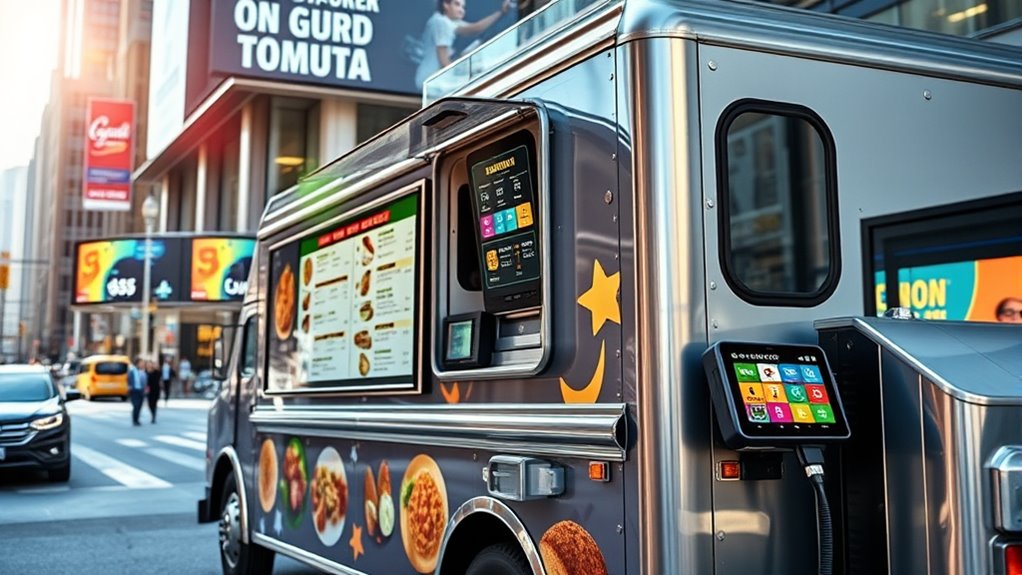
You’ll want to equip your food truck with wireless EMV chip card readers to guarantee quick, secure transactions. Integrating a mobile POS system can streamline your operations and keep everything organized on the go. These technologies help you serve customers faster and reduce payment errors.
Wireless EMV Chip Card Readers
Wireless EMV chip card readers have revolutionized payment processing for food trucks by offering a seamless and secure way to accept card payments on the go. With a reliable wireless EMV chip reader, you can process transactions quickly without being tethered to a terminal. Imagine customers tapping or inserting their cards effortlessly, reducing wait times and increasing satisfaction. These devices are compact, lightweight, and easy to operate, fitting comfortably in your hand or bag. They also support contactless payments like Apple Pay and Google Pay, making transactions even faster. Picture a busy street, with your chip reader connecting smoothly via Bluetooth or Wi-Fi, ensuring your sales keep flowing. This technology boosts efficiency, security, and customer trust, essential for a successful food truck business.
Mobile POS System Integration
Integrating a mobile POS system into your food truck operations streamlines sales and enhances efficiency by allowing you to process transactions seamlessly from anywhere. With real-time data, you can monitor cash flow more accurately, ensuring you’re always aware of your sales performance. A mobile POS also simplifies inventory management by automatically updating stock levels with each sale, reducing errors and preventing shortages. This integration helps you stay organized during busy hours and improves customer service by shortening wait times. Plus, you can easily generate sales reports and track trends to optimize your menu and pricing strategies. Overall, a mobile POS system boosts operational control, keeps your cash flow healthy, and ensures your inventory stays well-managed, setting your food truck up for success.
Marketing and Growing Your Presence
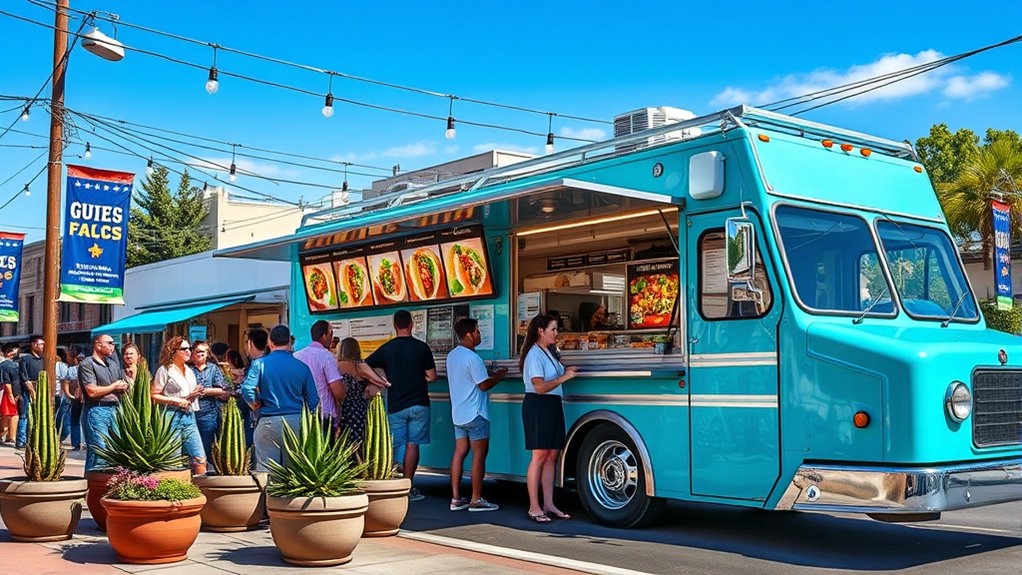
To grow your food truck’s presence in Ontario, CA, consider joining popular local events that attract food lovers. Implement customer loyalty programs and special offers to encourage repeat visits and build a loyal following. These strategies can substantially boost your visibility and help you stand out in a competitive market.
Popular Food Truck Events
Participating in popular food truck events is one of the most effective ways to boost your presence and attract new customers. These events draw large crowds enthusiastic to try unique cuisines, giving you valuable exposure. Make sure your food truck design stands out with eye-catching colors and clear branding, helping people remember you. Before joining, obtain the necessary vendor permits to ensure smooth entry and compliance. Events like food festivals, farmers markets, and city celebrations create perfect opportunities to showcase your menu. You’ll also connect with other vendors, which can lead to collaborations. Visualize your truck surrounded by excited patrons, their stomachs rumbling, eager to sample your offerings. These events are essential for growing your reputation and building a loyal customer base in Ontario, CA.
Customer Loyalty Programs and Specials
After gaining exposure at popular food truck events, focusing on customer loyalty programs and specials can help turn new visitors into repeat customers. Implement loyalty punch cards to reward repeat business and encourage customers to return. Offer daily specials to create excitement and give customers a reason to visit regularly. Promote these deals through signage, social media, and word of mouth to maximize their reach. Consider offering discounts or free items after a certain number of punch card visits, making your loyalty program enticing. Daily specials can highlight unique menu items or seasonal flavors, keeping your offerings fresh and engaging. These strategies not only increase customer retention but also boost overall sales, helping your food truck stand out in Ontario’s competitive food scene.
Local Event Participation Boosts Visibility

Joining local events can considerably increase your food truck’s visibility in Ontario, CA. It’s a prime chance to showcase your food truck branding and connect with the community. Participating in festivals, farmers’ markets, or street fairs puts your truck in front of new potential customers who are enthusiastic to try local food trends. You’ll stand out among other vendors and create memorable impressions. Picture your truck surrounded by excited crowds, the aroma drawing in hungry attendees, and your branding catching eyes from afar. These events also give you opportunities to gather feedback, build relationships, and boost your reputation. By actively engaging in local happenings, you turn passersby into loyal customers, making your food truck a staple in Ontario’s vibrant food scene.
Frequently Asked Questions
What Permits Are Required Specifically for Mobile Food Vendors in Ontario, CA?
You need a health permit from the Ontario County Environmental Health Department and a mobile food facility permit from the California Department of Food and Agriculture. Also, secure a business license and a parking permit from the city. For your food truck branding, make sure your signage complies with local regulations. Use social media marketing to attract customers, but remember to include your permits in your marketing to build trust and credibility.
How Do Health Inspections Differ for Food Trucks Versus Brick-And-Mortar Restaurants?
Did you know food trucks face stricter health inspections than brick-and-mortar restaurants? You’ll need to meet rigorous standards for food truck licensing and guarantee equipment sanitation is spotless. Inspections focus on mobile-specific issues like proper waste disposal and temperature controls during transit. Since trucks are more exposed to environmental elements, inspectors check for consistent cleanliness, making your vehicle’s hygiene essential to passing health standards.
What Are the Most Profitable Food Options for Ontario, CA Food Trucks?
You’ll find that tacos, gourmet burgers, and fusion dishes tend to be the most profitable for Ontario, CA food trucks. Focus on catering opportunities to boost sales during events and use social media marketing to attract more customers. Offering unique, shareable items helps generate buzz and repeat business, ultimately increasing your profit margin. Keep your menu flexible and seasonal to stay appealing and maximize your earning potential.
How Can I Find Reliable Suppliers and Vendors Locally?
To find reliable local suppliers and vendors, start by visiting nearby farmer markets to connect with fresh produce providers. Check out equipment suppliers in Ontario, CA for dependable kitchen tools and truck modifications. Network with other food truck owners through social media groups or local business events, and ask for recommendations. Building relationships with reputable farmers and equipment vendors ensures you get quality supplies consistently, helping your food truck succeed.
What Insurance Coverage Is Recommended for Food Truck Operations?
You should get extensive insurance that covers liability, property, and vehicle damage to protect your food truck. While meeting food safety standards is vital, don’t forget mobile marketing’s role in your success. Adequate coverage guarantees you’re protected during busy events and unexpected accidents, allowing you to focus on perfecting your menu and engaging customers, turning your passion into a thriving business without the fear of financial setbacks.
Conclusion
Starting your food truck in Ontario, CA, is an exciting journey that combines creativity with smart planning. Did you know that food trucks in California generate over $2 billion annually? By following these steps, you’ll set yourself up for success. Focus on a solid business plan, local regulations, and effective marketing. With dedication, your food truck can become a beloved part of Ontario’s vibrant food scene and a profitable venture.
